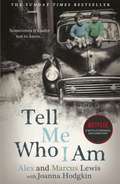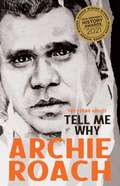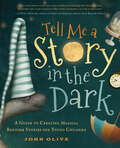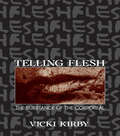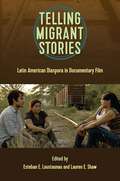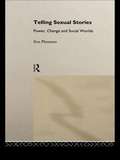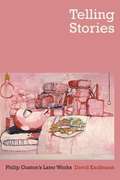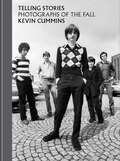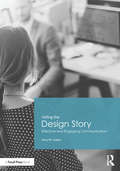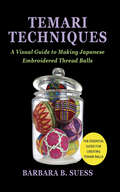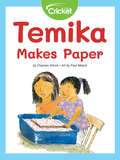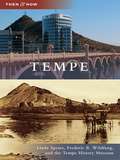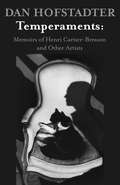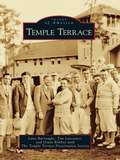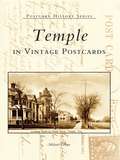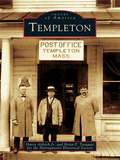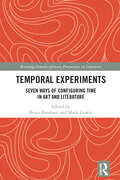- Table View
- List View
Tell Me No Lies (Follow Me Back #2)
by A. V. GeigerRealEricThorn No one knows what happened to pop icon Eric Thorn. His Twitter account? Frozen. His cell phone? Cracked and bloody, buried in the snow. Snowflake734Tessa Hart knows the truth, but she's finally left her #EricThornObsessed days behind. She has no intention of ever touching her Twitter app again. But SnapChat...That's safer, right? Agoraphobic fangirl Tessa Hart has finally left her house—only to trade one hiding place for another. But she can only stay out of sight for so long before she's forced to face the deadly consequences of the past. Back in an interrogation room, answers only lead to more questions in the pulse-pounding conclusion to the Follow Me Back duology.
Tell Me Who I Am: The Story Behind the Netflix Documentary
by Joanna Hodgkin Alex And Marcus LewisThe story behind the hit Netflix documentary: The bestselling account of the bond between brothers and the shocking legacy of a dangerous mother.Imagine waking up one day to discover that you have forgotten everything about your life. Your only link with the past, your only hope for the future, is your identical twin.Now imagine, years later, discovering that your twin had not told you the whole truth about your childhood, your family, and the forces that had shaped you. Why the secrets? Why the silences? You have no choice but to begin again.This has been Alex's reality: a world where memories are just the stories people tell you, where fact and fiction are impossible to distinguish. With dogged courage he has spent years hunting for the truth about his hidden past and his remarkable family. His quest to understand his true identity has revealed shocking betrayals and a secret tragedy, extraordinary triumph over crippling adversity and, above all, redemption founded on brotherly love.Marcus his twin brother has sometimes been a reluctant companion on this journey, but for him too it has led to staggering revelations and ultimately the shedding of impossible burdens. Their story spans continents and eras, from 1950s debutantes and high society in the Home Counties to a remote island in the Pacific and 90s raves. Disturbing, funny, heart-breaking and affirming, Alex and Marcus's determination to rebuild their lives makes us look afresh at how we choose to tell our stories.
Tell Me Why for Young Adults
by Archie Roach&‘There are many Australian stories, and mine is just one about what happened to me and other First Peoples of this country. It&’s important for me to tell my story – because it&’s not just part of my healing but of this country&’s as well. We all have a story and as you read this book I would like you to think of your own story, what that means and who is also a part of your story.&’ In his inspirational, highly acclaimed memoir – and including reflections from First Nations Elders and young people – Archie Roach tells the story of his life and his music. Only two when he was forcibly removed from his family, and brought up by a series of foster parents until his early teens, Archie&’s world imploded when he received a letter that spoke of a life he had no memory of. It took him almost a lifetime to find out who he really was. Tell Me Why is an unforgettable story of resilience, strength of spirit and hope.
Tell Me a Story in the Dark: A Guide to Creating Magical Bedtime Stories for Young Children
by John OliveTonight, don't read your child a story. Instead, dim the light, lie down, and create storytelling magic. Weave a spell that will enchant your child. . .Written by an award-winning playwright, Tell Me A Story In The Dark provides you with every tool you need to tell great and entertaining stories. In a day when parents want to spend more quality time with their children, Tell Me A Story In The Dark:Shows you how to prepare and tell a story.Communicates the enormous benefits—ending the bedtime battle of wills, building vocabulary, making room for effective parenting moments.Provides a treasure trove of stories that parents (and grandparents) can adapt for their children.Teaches you how to make up and tell your own stories.Anyone who loves children will love this book.
Telling Flesh: The Substance of the Corporeal
by Vicki KirbyFirst Published in 1997. Routledge is an imprint of Taylor & Francis, an informa company.
Telling Migrant Stories: Latin American Diaspora in Documentary Film (Reframing Media, Technology, and Culture)
by Esteban E. Loustaunau and Lauren E. ShawIn the media, migrants are often portrayed as criminals; they are frequently dehumanized, marginalized, and unable to share their experiences. Telling Migrant Stories explores how contemporary documentary film gives voice to Latin American immigrants whose stories would not otherwise be heard.The essays in the first part of the volume consider the documentary as a medium for Latin American immigrants to share their thoughts and experiences on migration, border crossings, displacement, and identity. Contributors analyze films including Harvest of Empire, Sin país, The Vigil, De nadie, Operation Peter Pan: Flying Back to Cuba, Abuelos, La Churona, and Which Way Home, as well as internet documentaries distributed via platforms such as Vimeo and YouTube. They examine the ways these films highlight the individual agency of immigrants as well as the global systemic conditions that lead to mass migrations from Latin American countries to the United States and Europe.The second part of the volume features transcribed interviews with documentary filmmakers, including Luis Argueta, Jenny Alexander, Tin Dirdamal, Heidi Hassan, and María Cristina Carrillo Espinosa. They discuss the issues surrounding migration, challenges they faced in the filmmaking process, the impact their films have had, and their opinions on documentary film as a force of social change. They emphasize that because the genre is grounded in fact rather than fiction, it has the ability to profoundly impact audiences in a way narrative films cannot. Documentaries prompt viewers to recognize the many worlds migrants depart from, to become immersed in the struggles portrayed, and to consider the stories of immigrants with compassion and solidarity. Contributors: Ramón Guerra | Lizardo Herrera | Jared List | Esteban Loustaunau | Manuel F. Medina | Ada Ortúzar-Young | Thomas Piñeros Shields | Juan G. Ramos | Lauren Shaw | Zaira Zarza A volume in the series Reframing Media, Technology, and Culture in Latin/o America, edited by Héctor Fernández L'Hoeste and Juan Carlos Rodríguez
Telling Sexual Stories: Power, Change, And Social Worlds
by Ken PlummerThis book explores the rites of a sexual story-telling culture. Taking three major examples - rape stories, coming-out stories, recovery stories - it examines the nature of these newly emerging narratives and the socio-historical conditions which have given rise to them. It looks at the rise of the women's movement, the lesbian and gay movement and the 'recovery' movement as harbingers of significant social change that encourage the telling of new stories.
Telling Stories: Philip Guston's Later Works
by David KaufmannGuston was best known for abstract work and cartoons. In this book, the author follows the development of his painting from the early 1960s until the artist's death in 1980 and explores his intense and complicated relationship to Judaism.
Telling Stories: Photographs of The Fall
by Kevin Cummins'No one has captured the look of alternative UK music over the past half a century more tellingly than Kevin Cummins.' - Simon Armitage'Kevin Cummins is a true master in being able to capture the essence of music, the soul of the band. Whatever he does however he does it is a mystery to me but it's pure genius.' - Rankin'Few photographers had such a close connection to The Fall as Manchester-based Kevin Cummins, and his new book, Telling Stories, is a rich visual history of one of the city's most beloved and enduring bands.' - Record Collector Magazine 'Kevin has the uncanny ability of capturing the inner mood of musicians. Be it the dynamics within a pensive Joy Division, or the sense surrounding the fledgeling Fall that something special was around the corner for us all. Kevin's book is nothing less than a remarkable document of a bewildering and defiant anti-fashion movement born in Prestwich, north Manchester in the grimy mid-70s.' - Marc Riley'Capturing forty years of the band's career via his archive, the legendary photographer (whose recent book, Juvenes, documented the story of Joy Division) gives his take on the phenomenon of The Fall and the late, great Mark E. Smith.' - Vive le Rock Contains never-before-seen images.Foreword by Simon Armitage, Poet Laureate. From chaotic early gigs to their final years, NME photographer Kevin Cummins provides a definitive, unique perspective on cult favourites The Fall. In this stunning visual history spanning four decades, discover how and why they emerged as one of the most innovative, boundary-breaking bands in modern music.With a foreword by Poet Laureate and Fall fan Simon Armitage and an interview with Eleni Poulou, as well as never-before-seen images from Cummins' archive, this is the ultimate visual companion to The Fall.
Telling Stories: Photographs of The Fall
by Kevin Cummins'No one has captured the look of alternative UK music over the past half a century more tellingly than Kevin Cummins.' - Simon Armitage'Kevin Cummins is a true master in being able to capture the essence of music, the soul of the band. Whatever he does however he does it is a mystery to me but it's pure genius.' - Rankin'Few photographers had such a close connection to The Fall as Manchester-based Kevin Cummins, and his new book, Telling Stories, is a rich visual history of one of the city's most beloved and enduring bands.' - Record Collector Magazine 'Kevin has the uncanny ability of capturing the inner mood of musicians. Be it the dynamics within a pensive Joy Division, or the sense surrounding the fledgeling Fall that something special was around the corner for us all. Kevin's book is nothing less than a remarkable document of a bewildering and defiant anti-fashion movement born in Prestwich, north Manchester in the grimy mid-70s.' - Marc Riley'Capturing forty years of the band's career via his archive, the legendary photographer (whose recent book, Juvenes, documented the story of Joy Division) gives his take on the phenomenon of The Fall and the late, great Mark E. Smith.' - Vive le Rock Contains never-before-seen images.Foreword by Simon Armitage, Poet Laureate. From chaotic early gigs to their final years, NME photographer Kevin Cummins provides a definitive, unique perspective on cult favourites The Fall. In this stunning visual history spanning four decades, discover how and why they emerged as one of the most innovative, boundary-breaking bands in modern music.With a foreword by Poet Laureate and Fall fan Simon Armitage and an interview with Eleni Poulou, as well as never-before-seen images from Cummins' archive, this is the ultimate visual companion to The Fall.
Telling the Bees and Other Customs: The Folklore of Rural Crafts
by Mark NormanThroughout the history of civilisation, traditional crafts have been passed down from hand to skilled hand. Blacksmithing, brewing, beekeeping, baking, milling, spinning, knitting and weaving: these skills held societies together, and so too shaped their folklore and mythology.Exploring the folklore connected with these rural crafts, Telling the Bees examines the customs, superstitions and stories woven into some of the world’s oldest trades. From the spinning of the Fates to the blacksmith’s relationship with the devil, and the symbolism of John Barleycorn to a ritual to create bees from the corpse of a cow – these are the traditions upon which our modern world was built.
Telling the Design Story: Effective and Engaging Communication
by Amy HuberWhen presenting projects in competitive design environments, how you say something is as important as what you’re actually saying. Projects are increasingly complex and designers are working from more sources, and many designers are familiar with the struggle to harness this information and craft a meaningful and engaging story from it. Telling the Design Story: Effective and Engaging Communication teaches designers to craft cohesive and innovative presentations through storytelling. From the various stages of the creative process to the nuts and bolts of writing for impact, speaking skills, and creating visuals, Amy Huber provides a comprehensive approach for designers creating presentations for clients. Including chapter by chapter exercises, project briefs, and forms, this is an essential resource for students and practicing designers alike.
Telltale Women: Chronicling Gender in Early Modern Historiography (Women and Gender in the Early Modern World)
by Allison Machlis MeyerTelltale Women fundamentally reimagines the relationship between the history play and its source material as an intertextual one, presenting evidence for a new narrative about how—and why—these genres disparately chronicle the histories of royal women. Allison Machlis Meyer challenges established perceptions of source study, historiography, and the staging of gender politics in well-known drama by arguing that chronicles and political histories frequently value women&’s political interventions and use narrative techniques to invest their voices with authority. Dramatists who used these sources for their history plays thus encountered a historical record that offered surprisingly ample precedents for depicting women&’s perspectives and political influence as legitimate, and writers for the commercial theater grappled with such precedents by reshaping source material to create stage representations of royal women that condemned queenship and female power. By tracing how the sanctioning of women&’s political participation changes from the narrative page to the dramatic stage, Meyer demonstrates that gender politics in both canonical and noncanonical history plays emerge from playwrights&’ intertextual engagements with a rich alternative view of women in the narrative historiography of the sixteenth and seventeenth centuries.
Temari Techniques: A Visual Guide to Making Japanese Embroidered Thread Balls
by Barbara B. SuessBringing a time-honored art form into the modern needle-working world, this visually rich how-to guide reveals the techniques of Japanese temari balls. Anyone with an interest in fabric arts, particularly Japanese arts and design, can master stitching techniques and layer threads to create pattern, color, and texture. There are more than 40 easy-to-follow patterns to help fine-tune this skill set that will appeal to not only temari enthusiasts, but to quilters and embroiderers as well. Step-by-step directions and detailed drawings explain each technique, while mini patterns aid in practicing the new skills and help to lay the groundwork for individual and unique designs. This volume is great for beginners and for those stitchers looking for new challenges and intermediate temari designs. The book is more than a collection of patterns: once the basic techniques have been mastered, instruction is provided on how to combine patterns on the same ball to create a unique temari. A guide for left-handed stitchers is also provided.
Temika Makes Paper
by Charnan Simon Paul MeiselTemika and her family are big on recycling paper. Temika and her brother Tyler are ready to argue about where paper comes from – trees or recycled paper. Mom says they’re both right! Dad suggests they make their own paper so that Temika can use it for her Grandma’s birthday card. Mom teaches them how to make homemade paper from scraps of white paper, colored construction paper, and even flowers!
Tempe
by Frederic B. Wildfang Linda Spears Tempe History MuseumCharles Trumbull Hayden built the first canal on the south side of the Salt River in 1870. Soon after, he built a store, a flour mill, and a cable ferry across the river, and he started a town. Since then, Tempe has changed from a small farming community to a lively urban center. Moreover, Tempe's residential growth has made it the seventh-largest town in Arizona. Author Frederic B. Wildfang documents the history. Photographer Linda Spears illustrates the changes.
Temperaments: Memoirs of Henri Cartier-Bresson and Other Artists
by Dan HofstadterIn these five profiles, four of which originally appeared in the New Yorker, the author evokes the life and work of seven gifted artists. Among those presented, often through lively conversations, are Jean Hélion, Mark Rothko, R.B. Kitaj, and Dennis Creffield. Chief among those portrayed however is Henri Cartier-Bresson (1908-2004), the great French photographer and photojournalist who, famed for dodging contact with the press, is here sketched in rare and fond detail. Of all these artists, only two still live: what emerges from this book is a picture, often bizarre, often hilarious, of a bygone bohemian world.
Temple Terrace (Images of America)
by 999 Lana Burroughs Grant Rimbey Tim LancasterThe influential and adventurous Chicago socialite Mrs. Potter Palmer (Bertha) struck out for Florida in 1910, eventually buying thousands of acres of land across the state. In 1914, after setting up residence in Sarasota, she established Riverhills, a hunting preserve on 19,000 acres in the area now known as Temple Terrace. Local historians believe it was Palmer's vision to create one of America's first planned golf course communities, where every Mediterranean Revival villa sold would include its own grove. Intended to provide a hobby and part-time income for the wealthy Northerners lured to the Sunshine State, 5,000 acres were planted with the exotic hybrid Temple orange--making up the largest citrus grove in the world at the time. The new city was named after the orange and for the sloping terrain of the land along the Hillsborough River.
Temple in Vintage Postcards
by Michael LefanFounded in 1881 by the Gulf, Colorado & Santa Fe Railway Company, Temple, Texas became a railroad town overnight. The company purchased 181 acres and then auctioned off parcels to prospective buyers interested in providing services for railroad equipment and passengers. Though early on Temple had several unfortunate nicknames--"Mudville," "Tanglefoot," and "Ratsville"--it soon shed its image as a muddy, rat-infested land, became a major junction for four railway lines, and offered a land of opportunity for commerce. The railway would bring flattering new nicknames like "Progressive Temple" and "Prairie Queen" as well as a chance to be part of the American Dream.
Temple to Love: Architecture and Devotion in Seventeenth-Century Bengal
by Pika Ghosh"[A]n excellent analytical study of a sensationally beautiful type of temple. . . . This work is not just art historical but embraces . . . religious studies, anthropology, history, and literature." —Catherine B. Asher"[A]dvances our knowledge of . . . Bengali temple building practices, the complex inter-reliance between religion, state power, and art, and the ways in which Western colonial assumptions have distorted correct interpretation. . . . A splendid book." —Rachel Fell McDermottIn the flux created by the Mughal conquest, Hindu landholders of eastern India began to build a spectacularly beautiful new style of brick temple, known as Ratna. This "bejeweled" style combined features of Sultanate mosques and thatched houses, and included second-story rooms conceived as the pleasure grounds of the gods, where Krishna and his beloved Radha could rekindle their passion. Pika Ghosh uses art historical, archaeological, textual, and ethnographic approaches to explore this innovation in the context of its times. Includes 82 stunning black-and-white images of rarely photographed structures.Published in association with the American Institute of Indian Studies
Temple to the Wind: Nathanael Herreshoff and the Yacht that Transformed the America's Cup
by Christopher L. PastoreIn 1903, racing for the America’s Cup was no longer a gentleman’s game – it had become a race entangled with political tension and awesome, dangerous stakes. In this pivotal year, the two great rivals Britain and America raced head to head, with Britain determined to win with their privately funded Shamrock III, and America’s bravado backed up by Reliance. Reliance was a yacht like no other – a work of beauty carrying more sail than any single-masted boat before. Some believed that the boat towering 190 feet above the water was simply too dangerous, but the race called for such staggering risk.Pastore brings life to this strikingly astounding vessel from conception, to construction, to the hair-raising trials at sea. It is simply one of the most exciting sea tales ever told.
Temples of Sound: Inside the Great Recording Studios
by William Clark Jim CoganAll great music has a birthplace. Temples of Sound tells the stories of the legendary studios where musical genius and a magical space came together to capture some of the most exciting jazz, pop, funk, soul, and country records ever made. From the celebrated Southern studios of Sun and Stax to the John Coltrane/Miles Davis sessions in producer Rudy Van Gelder's living room, to Frank Sinatras swinging cuts at state-of-the-art Capitol Records, each of the 15 profiles in this book brings great music to life at the moment of its creation. With a trove of never-before-seen photographs and fascinating, all-new interviews with the musicians and producers who made the records, Temples of Sound is a rich inspiration for music fans.
Temples of the Earthbound Gods
by Christopher Thomas GaffneyIn Rio de Janeiro, the spiritual home of world football, and Buenos Aires, where a popular soccer club president was recently elected mayor, the game is an integral part of national identity. Using the football stadium as an illuminating cultural lens, Temples of the Earthbound Gods examines many aspects of urban culture that play out within these monumental architectural forms, including spirituality, violence, rigid social norms, anarchy, and also expressions of sexuality and gender. Tracing the history of the game in Brazil and Argentina through colonial influences as well as indigenous ball courts in Mayan, Aztec, Zapotec, Mixtec, and Olmec societies, Christopher Gaffney's study spans both ancient and contemporary worlds, linking the development of stadiums to urbanization and the consolidation of nation building in two of Latin America's most intriguing megacities.
Templeton
by Brian P. Tanguay Harry Aldrich Jr. Narragansett Historical SocietyThe villages of Templeton, originally called Narragansett, were founded in the mid-eighteenth century along the banks of the region's rivers and ponds. With adequate water power, agriculture and industry flourished, producing hay, corn, wool, paper, bricks, iron kitchenware, and all types of furniture. Templeton shares the history of the villages through the vintage photographs of Oren Williams and Wallace Underwood, two professional photographers who captured life there from the late 1800s to the early years of the twentieth century. Highlights include John Boynton, village tinsmith who founded Worcester Polytechnic Institute; the Templeton Hotel, which was destroyed by fire in 1888; and the Narragansett House, a popular destination for sleighing and school parties.
Temporal Experiments: Seven Ways of Configuring Time in Art and Literature (Routledge Interdisciplinary Perspectives on Literature)
by Marit Grøtta Bruce BarnhartTemporal Experiments: Seven Ways of Configuring Time in Art and Literature conducts an expansive exploration of different modes of timing. Its seven chapters pursue the question of time as it is embodied in key figures that shape both aesthetic and pragmatic life. Working closely with literary, visual, and musical artworks, the book aims to provoke new ways of engaging with the question of time. It treats artworks as experiments that launch temporal figures, and that test out the possibilities and connections these different figures enable. Thus, the book seizes upon works by artists like Anne Carson, King Tubby, and Raymond Queneau as opportunities for thinking through the valence of both existing and untested temporal configurations. What other modes of shaping time, it asks, might be conjured out of the viewing of an Omer Fast film, the reading of a poem by Baudelaire, or of a novel by Tom McCarthy? In treating artworks as temporal experiments, this book stresses the fact that artworks always experiment with the raw materials of time, fashioning it or refashioning it into novel combinations. This book follows the imperatives of these experiments in order to advance a nuanced understanding of the way time insinuates itself into all aspects of social and intellectual life.

